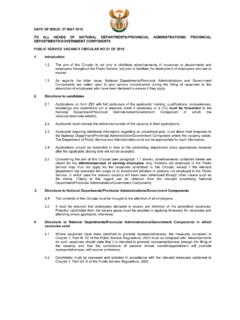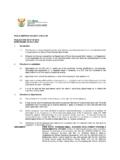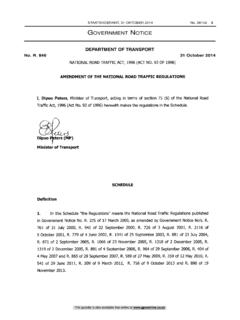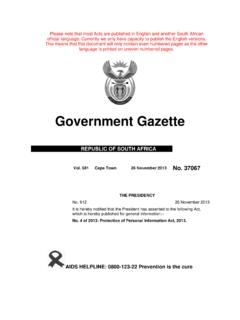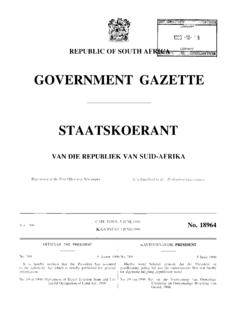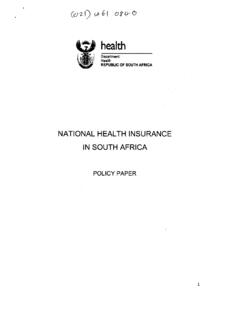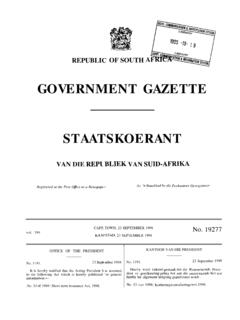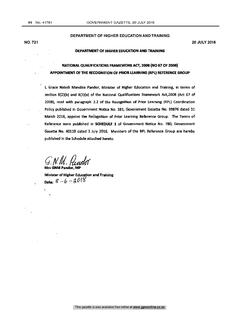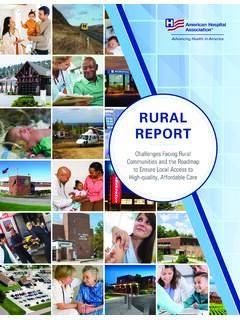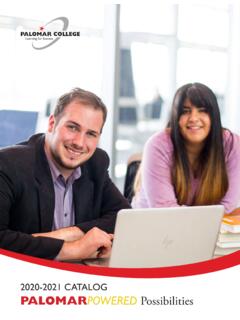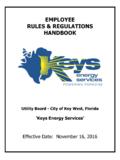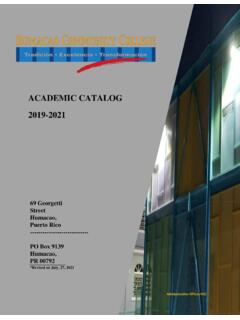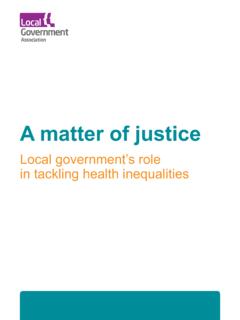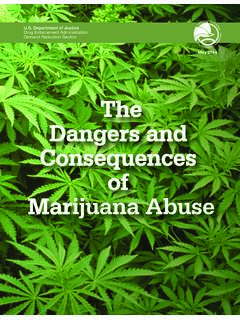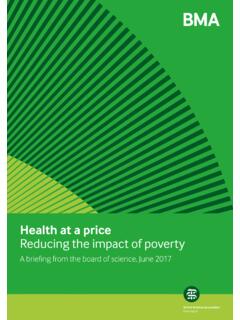Transcription of NATIONAL DRUG MASTER PLAN - Gov
1 NATIONAL drug . MASTER plan . 4TH EDITION | 2019 TO 2024. SOUTH AFRICA FREE OF. SUBSTANCE ABUSE. Building a Caring Society Together. NATIONAL drug MASTER plan . 4 TH EDITION. 2019 TO 2024. SOUTH AFRICA FREE OF SUBSTANCE ABUSE. LIST OF ACRONYMS. Acronym Explanation AIDS Acquired immunodeficiency syndrome ATS Amphetamine-type stimulants ( Ecstasy tablets and tik'). AU African Union CAT Methcathinone (ATS with similar effects to amphetamine). CBO community -Based Organisation CBRTA Cross Border Road Transport Agency CCF Crime Combating Forum CDA Central drug Authority CND Commission for Narcotic Drugs CNS Central Nervous System COG Cooperative Governance CONTRALESA Congress of Traditional Leaders of South Africa CPPRCRLC Commission for the Promotion and Protection of the Rights of Cultural, Religious, and Linguistic Communities CSIR Council for Scientific and Industrial Research DBE Department of Basic Education DALRRD Department of Agriculture, Land Reform and Rural Development DCS Department of Correctional Services DEL Department of Employment and Labour DEA drug Enforcement Administration DIRCO Department of International Relations and Co-operation DMP drug MASTER plan DOH Department of Health DHA Department of Home Affairs DHET Department of Higher Education and Training DOJ&CD Department of Justice and Constitutional Development DOT Department of Transport DPCI Directorate for Priority Crime Investigation DPME Department of Planning, Monitoring and Evaluation 2| NATIONAL drug MASTER plan 4TH EDITION 2019 TO 2024.
2 SOUTH AFRICA FREE OF SUBSTANCE ABUSE. Acronym Explanation DST Department of Science and Technology DSD Department of Social Development DSAC Department of Sports, Arts and Culture DTA Department of Traditional Affairs DTI Department of Trade and Industry FBO Faith-Based Organisation FIC Financial Intelligence Centre FSL Forensic Science Laboratories (F)SW (Female) Sex Workers FOSAD Forum of South African Director Generals GCIS Government Communication and Information System GDP Gross Domestic Product HIV Human Immunodeficiency Virus INCB International Narcotics Control Board KPI Key Performance Indicator LDAC Local drug Action Committee LSD Lysergic acid diethylamide MA Methamphetamine M&E Monitoring and Evaluation MDMA 3,4-methylenedioxy-methamphetamine MEC Member of the Executive Committee MLA Mutual Legal Assistance MLA Multilateral Agreement MOU Memorandum of Understanding MSM Men who have Sex with Men NDMP NATIONAL drug MASTER plan NGO Non-Governmental Organisation NPA NATIONAL Prosecuting Authority NT NATIONAL Treasury NYDA NATIONAL Youth Development Agency OTC Over the Counter medication NATIONAL drug MASTER plan 4TH EDITION 2019 TO 2024.
3 SOUTH AFRICA FREE OF SUBSTANCE ABUSE |3. Acronym Explanation OTC/PRE Over the Counter/Prescription Medication PCA Provincial AIDS Council PSAF Provincial Substance Abuse Forum SACENDU South African community Epidemiology Network on drug Use SADC Southern African Development community SAHPRA South African Health Products Regulatory Authority SAIDS South African Institute for drug Free Sport SALGA South African Local Government Association SAMRC South African Medical Research Council SANAC South African NATIONAL AIDS Council SANC South African Nursing Council SANCA South African NATIONAL Council on Alcoholism and drug Dependence SANEB South African Narcotics Enforcement Bureau SAPS South African Police Service SARS South African Revenue Service STI Sexually Transmitted Infection SUD Substance Use Disorder TB Tuberculosis THC Tetrahydrocannabinol UNDCP United Nations drug Control Programme UNODC United Nations Office on Drugs and Crime WHO World Health Organization 4| NATIONAL drug MASTER plan
4 4TH EDITION 2019 TO 2024. SOUTH AFRICA FREE OF SUBSTANCE ABUSE. GLOSSARY OF TERMS. Term Explanation Addiction Addiction is a chronic, relapsing disease that affects both the brain and behaviour. In many but not all cases, it involves the use of nicotine, alcohol and other drugs. Addiction often originates with use in adolescence when the brain is still developing and is more vulnerable to their effects. If untreated, it can become a chronic and relapsing condition, requiring ongoing professional treatment and management (1)scientists studying drug abuse labored in the shadows of powerful myths and misconceptions about the nature of addiction. When scientists began to study addictive behavior in the 1930s, people addicted to drugs were thought to be morally flawed and lacking in willpower. Those views shaped society\u2019s responses to drug abuse, treating it as a moral failing rather than a health problem, which led to an emphasis on punishment rather than prevention and treatment.
5 Today, thanks to science, our views and our responses to addiction and other substance use disorders have changed dramatically. Groundbreaking discoveries about the brain have revolutionized our understanding of compulsive drug use, enabling us to respond effectively to the problem. As a result of scientific research, we know that addiction is a disease that affects both the brain and behavior. We have identified many of the biological and environmental factors and are beginning to search for the genetic variations that contribute to the development and progression of the disease. Scientists use this knowledge to develop effective prevention and treatment approaches that reduce the toll drug abuse takes on individuals, families, and communities. Despite these advances, many people today do not understand why people become addicted to drugs or how drugs change the brain to foster compulsive drug use. This booklet aims to fill that knowledge gap by providing scientific information about the disease of drug addiction, including the many harmful consequences of drug abuse and the basic approaches that have been developed to prevent and treat substance use disorders.
6 At the NATIONAL Institute on drug Abuse (NIDA). Aftercare Aftercare means ongoing professional support to a service user after a formal treatment episode has ended in order to enable him or her to maintain sobriety or abstinence, personal growth and to enhance self-reliance and proper social functioning (2). Alcohol Alcohol is a psychoactive substance with dependence-producing properties that has been widely used in many cultures(3). Also see definition of Liquor'. Amphetamine type ATS refer to a group of drugs, mostly synthetic in origin, whose principal members stimulants (ATS) include amphetamine, methamphetamine, and MDMA. The use of these substances stimulates the CNS(4). A range of other substances also falls into this group, including ephedrine, pseudoephedrine, and methylphenidate. Smoking, sniffing and inhaling are the most popular methods of ATS use. Examples of street names are: ice, tik, speed, fast, up, whiz, and crystal. NATIONAL drug MASTER plan 4TH EDITION 2019 TO 2024.
7 SOUTH AFRICA FREE OF SUBSTANCE ABUSE |5. Term Explanation Benzodiazepine Benzodiazepines is a structural group of CNS depressants that are widely used in medicine as anti-convulsants, anxiolytics, hypnotics, sedatives, skeletal muscle relaxants and tranquilizers(4). Benzodiazepines are sometimes crushed and snorted or dissolved and injected. Examples of street names are: benzos, temazies, jellies, moggies, eggs, vallies, norries, green eggs, and rugby balls. Cannabis Cannabis refers to any of the preparations or chemicals that are derived from the hemp plant and are psychoactive (Merriam Webster Dictionary). It is usually smoked separately or in combination with other drugs. Examples of street names include dagga, marijuana, weed, pot, grass, zol, skyf, ganja, hash, joint, and dope. Central nervous The CNS is the part of the nervous system that consists of the brain and spinal cord system (CNS) (Merriam Webster Dictionary). Clandestine Laboratories where illicit drug manufacturing is marked by, held in, or conducted in laboratory secret (Merriam Webster Dictionary).
8 Codeine Codeine and morphine are the most important extracts from opium (4). Codeine can be found in most cough mixtures, sinus medication, and painkillers. South Africa is one of very few countries still selling codeine-based products over the counter without a doctor's prescription. Examples of street names include syrup, purple drank, and cody. Cocaine Cocaine is the main psychoactive alkaloid obtained from coca leaves. It is generally produced in two forms which differ in their route of administration. Cocaine hydrochloride, which is inhaled or injected, and cocaine base, which is smoked (Crack). (4). Examples of street names include rocks, klippe, crack, coke, Charlie, C, snow, blow, line, bump, yayo, and llelo. Continuum of Care Continuum of care describes service delivery systems in which treatment for SUD. typically involves some phase of care beyond the initial acute care episode (5). Demand reduction Demand reduction: A general term used to describe policies or programmes directed at reducing the consumer demand for psychoactive drugs.
9 It is mainly applied to illicit drugs, particularly with reference to education, treatment and rehabilitation strategies as opposed to law enforcement strategies aimed at preventing the production and distribution of drugs(6). drug A drug is a medicine or other substance, which has a physiological effect when ingested or otherwise introduced ( inhaled, injected, smoked, consumed, absorbed via a patch) into the body (Oxford English Dictionary). Drugs can be natural or synthetic. The terms drug ', substance', and narcotic' are used interchangeably. drug use drug use is defined as the self-administration of psychoactive substances (6), the use of any substance that has the potential to affect perception, mood, cognition, behaviour or motor function when taken (7). Of concern are licit substances, such as alcohol, tobacco, Over-the-Counter (OTC) and prescription medicine as well as inhalants, and illicit substances such as cannabis, cocaine, and heroin. 6| NATIONAL drug MASTER plan 4TH EDITION 2019 TO 2024.
10 SOUTH AFRICA FREE OF SUBSTANCE ABUSE. Term Explanation Early Intervention A therapeutic strategy that combines early detection of hazardous or harmful substance use and treatment of those involved. Treatment is offered or provided prior to patients presenting of their own volition and, in many cases, before they become aware that their substance use may cause problems. It is directed particularly at individuals who have not developed a physical dependency or major psychosocial complications (6). Family and Social Refers to an intimate, family, kinship and any relationships that are supportive of recovery Capital efforts (16). Harm reduction A harm reduction philosophy emphasises the development of policies and programmes that focus directly on reducing the social, economic, and health related harm resulting from the use of alcohol or drugs. Harm reduction interventions are evidence-based public health principles to support people who use drugs (6). Heroin Heroin is an opioid drug made from morphine (4).

